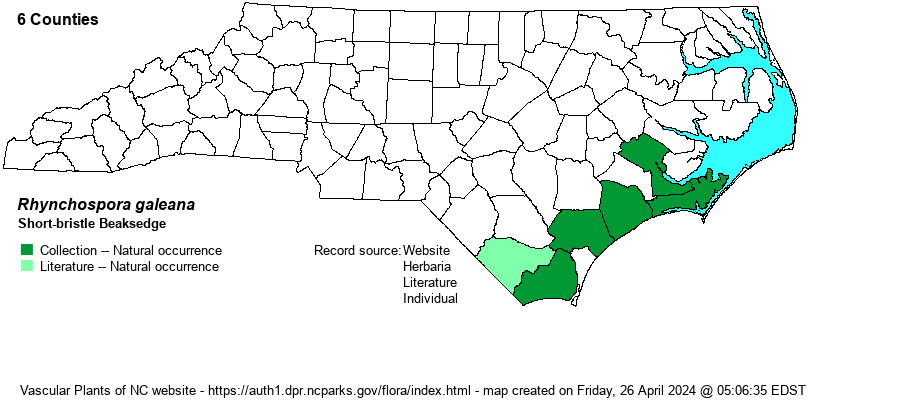| Section 5 » Order Cyperales » Family Cyperaceae |
Show/Hide Synonym
| taxonName | relationship | relatedTaxonName | relatedTaxonRefText | relComments |
|---|
| Rhynchospora galeana | = | Rhynchospora breviseta | Flora of North America (1993b, 1997, 2000, 2002a, 2002b, 2003a, 2004b, 2005, 2006a, 2006b, 2006c, 2007a, 2009, 2010) | | | Rhynchospora galeana | = | Rhynchospora breviseta | Godfrey and Wooten (1979, 1981) | | | Rhynchospora galeana | = | Rhynchospora breviseta | Kartesz (1999) | | | Rhynchospora galeana | = | Rhynchospora breviseta | Radford, Ahles, and Bell (1968) | | | Rhynchospora galeana | = | Rhynchospora breviseta | Wunderlin & Hansen Flora of Florida (3) | | | Rhynchospora galeana | = | Rhynchospora breviseta | Goetghebeur in Kubitzki (1998b). Distributions given for tropical America are largely derived from Thomas (1992). | (later homonym) | | Rhynchospora galeana | < | Rhynchospora oligantha | Fernald (1950) | | | Rhynchospora galeana | < | Rhynchospora oligantha | Gleason (1952) | | | Rhynchospora galeana | < | Rynchospora oligantha | Small (1933, 1938) | | | Rhynchospora galeana | = | Rynchospora oligantha var. breviseta | Goetghebeur in Kubitzki (1998b). Distributions given for tropical America are largely derived from Thomas (1992). | | | Source: Weakley's Flora |
|
| Author | Naczi, W. Knapp, & G. Moore | |
| Distribution | Southern outer Coastal Plain. A report from Cumberland County is almost certainly R. oligantha, which is known to occur there; it came from a vegetation survey plot, without a specimen collected.
Coastal Plain, NC to southern FL and southern MS; West Indies. | |
| Abundance | Uncommon. Often forms tussocks of many leaves and culms. Despite it not being a truly rare species -- the NCNHP database lists 38 records -- it is nonetheless tracked by that agency as Significantly Rare. | |
| Habitat | Frequently burned, wet Longleaf Pine savannas. Usually these conditions are met essentially only in protected or managed conservation lands, and thus the species is mostly restricted to such sites but can be locally numerous. |
| Phenology | Flowering and fruiting July-September. | |
| Identification | The species forms dense clumps or tussocks of threadlike leaves (less than 1/2 mm wide). The wispy flowering stems stick out a bit and produce only 2-4 spikelets, each acutely pointed. The seeds have short, feathery bristles (vs. bristles as long as the seed body in R. oligantha), and a short blunt beak (vs. long and pointed in that species). | |
| Taxonomic Comments | The current name replaces R. breviseta, in use for many decades.
Members of the genus Rhynchospora -- mainly called beaksedges but also called beakrushes -- are mostly Coastal Plain in distribution and are important members of our longleaf pine savannas, flatwoods, streamheads, depression ponds, Carolina bays, and beaver ponds. They vary from small and wiry to large and coarse. Keys concentrate on features of the achenes (seeds) and the shape and arrangement of the flower clusters (spikelets). The seeds may or not have bristles at their base; bristle number, length, and toothing are critical characters. Size and shape of the seed beaks is also critical. The drawings in Godfrey & Wooten (1979) are extremely helpful. The genus now includes Dichromena, the white-topped sedges. | |
| Other Common Name(s) | None | |
| State Rank | S2S3 | |
| Global Rank | G3? | |
| State Status | SR-P | |
| US Status | | |
| USACE-agcp | OBL link |
| USACE-emp | OBL link |

